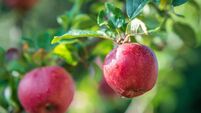Take out the seed packets to begin the new garden year

If you have not yet received any catalogues in the post, go online or pick up the phone and download/order your preferred seed supplier’s 2015 catalogue now.
Imagining your garden in July bursting with bounty and teaming with vegetables, herbs and edible flowers is the perfect antidote to these grey, long January days.
It is certainly too early to sow most seeds but it is essential to place orders early to ensure you avail of the best choices before stock levels run out.
If you are new to vegetable growing and scanning your first seed catalogue, you may be feeling super excited, if not a little overwhelmed by the plethora of possibilities before you.
Yesterday, lettuce was simply lettuce, however, now ‘Butterhead’, ‘Batavia’, ‘Cos’, ‘Crisp Head’, ‘Loose Leaf’ and ‘Winter’, with their hundreds of sub-varieties have arrived.
From risqué ‘Roxy’ and ‘Drunken Woman’ lettuce to twee-titled ‘Marvel of Four Seasons’, vegetable names can be just as intriguing as their unique tastes and appearance.
If you ask any seasoned vegetable grower, which varieties they grow, they will be sure to list off their ‘tried and tested’ favourites. Ask another gardener and you’ll probably get a different list. The good news is, that as you mature as a gardener, the more proficient you become at picking out exactly what varieties work best for your soil, space, climate and taste buds.
My advice is to shop local, as seeds saved and trialled in Ireland, will be most suited to growing in Ireland. Brown Envelope Seeds ( www.brownenvelopeseeds.com ) in West Cork and the Irish Seed Savers Association ( www.irishseedsavers.ie ) in Co Clare have lots of great Irish saved seeds including heritage varieties to choose from.
Home gardeners who have witnessed their precious vegetables succumb to disease or pests know only too well the devastating heartbreak that entails.
One helpful preventative measure is to use varieties that contain resistance to certain diseases or pests, without compromising flavour.
Potatoes like ‘Sarpo-Axona’ and ‘Sarpo Mira’ are blight resistant; parsnip ‘Javelin’ is resistant to canker; pea ‘Greenshaft is resistant to mildew and carrot ‘Flyaway’ has a higher resistance to carrot root-fly. Some vegetable varieties are slower to bolt, such as beetroot ‘Boltardy’ and lettuce ‘Fatima’.
Open-pollinated vegetable varieties are those that will grow true from seed. In other words, the seeds saved from these, once sown, will produce replicas of the parent plant. Open-pollinated varieties, tend to mature over a longer harvest window and are a must for self-reliant gardeners who wish to save seed.
These vegetables have been cultivated for generations for exactly that reason, and besides taste, most have other benefits such as productivity, tenderness, winter storage, hardiness and some of the older varieties also possess a natural resistance to pests and/or diseases.
By definition, heirloom varieties are open-pollinated, but how old a cultivar has to be to earn an heirloom title, is open to discussion.
On the other hand, hybrid varieties (often designated F1) will not grow true from seed, as they are the result of a cross between two different varieties of the same plant species, selected for desirable traits.
Cross breeding has been a common practice for centuries and is not to be confused with genetic modification.
Hybrids tend to possess ‘hybrid vigour’ and have consistent, uniform yields and cropping time. This is very important for the mechanical harvesting of 2,000 heads of lettuce in one day, but certainly less critical for the home grower.
Hybrid seeds are more expensive and cannot be used for seed saving.
If you are interested in sourcing F1 seeds in Ireland, check out Klaus Laitenberger’s seed shop on www.greenvegetableseeds.com where you can source the above varieties amongst a host of other great edibles, including heirlooms and open pollinated varieties.
Since nearly all packets and varieties of vegetable seeds come in far too great a quantity for the average home gardener, there is a good chance you may be currently throwing one eye over this year’s new seed catalogues and the other over last year’s half-full packets as you ponder how many of these older seeds are still viable — and how long do vegetable seeds last?
Unfortunately, there are no exact answers, but luckily there are some guidelines. As seeds are living things, much depends on what kind of seeds they are and how they are stored.
If seeds are kept in cool, dry conditions, they will last longer than those stored in warm, humid conditions. Some types of seeds are naturally more short-lived than others and most seasoned vegetable growers know that parsnip seed will not carry over from year to year.
The same is true for spinach but most other vegetable and flower seeds are relatively long-lived and remain viable for at least two years from packing.
From my own experience, seeds will last longer and germinate and grow, once kept in the right conditions. Seeds are happiest when stored in their original resealed packets in the fridge, but in the absence of original packets, place them in brown envelopes as this will help draw moisture away from them.
Ensure to label and write the year of purchase on envelopes before storing and always keep your seeds well organised, so that you can find what you need easily.
Older seeds tend to have lower germination rates, which may translate into a loss of your valuable time, space and energy and put your crops behind in the season. It is well advised to do a quick germination test to see if your seeds are worth sowing.
To do this, place 10 seeds on a damp sheet of kitchen paper. Fold the paper over, covering completely and place in a loosely-tied plastic bag allowing some air for healthy germination.
Label your bag before putting in a warm place. Check daily to ensure the towel does not dry out. Most seeds will germinate within 3-10 days but some flowers and herbs may take longer. If 9 seeds germinate, then there is a 90% germination rate, but if only 3 seeds germinate (30%), you might consider buying new seeds.
A simple test like this is ideal for ‘weeding’ out non-viable seed stores and unnecessary seed purchases, making it a practical precursor for a frugally fabulous successful season ahead. Get set.












